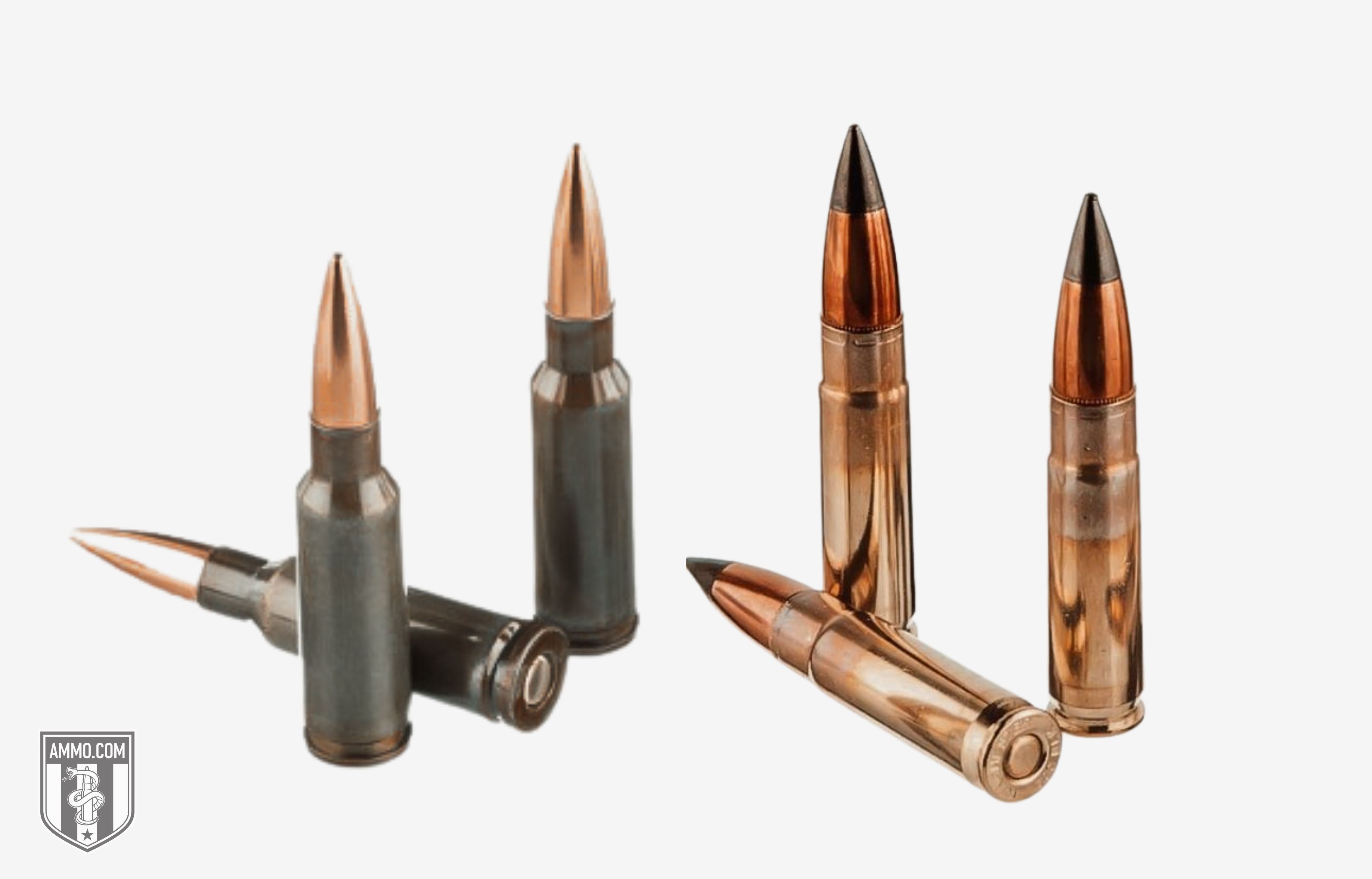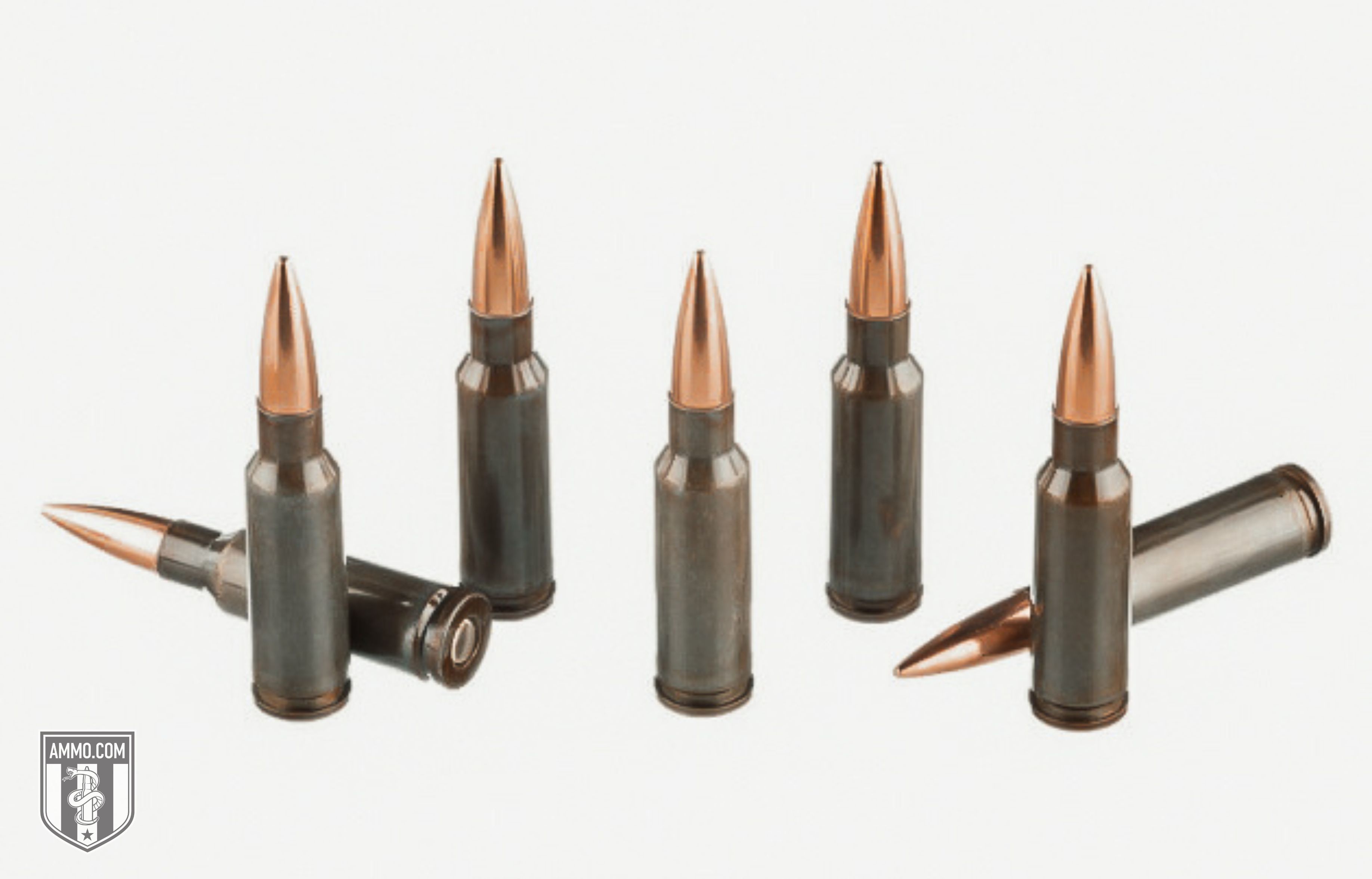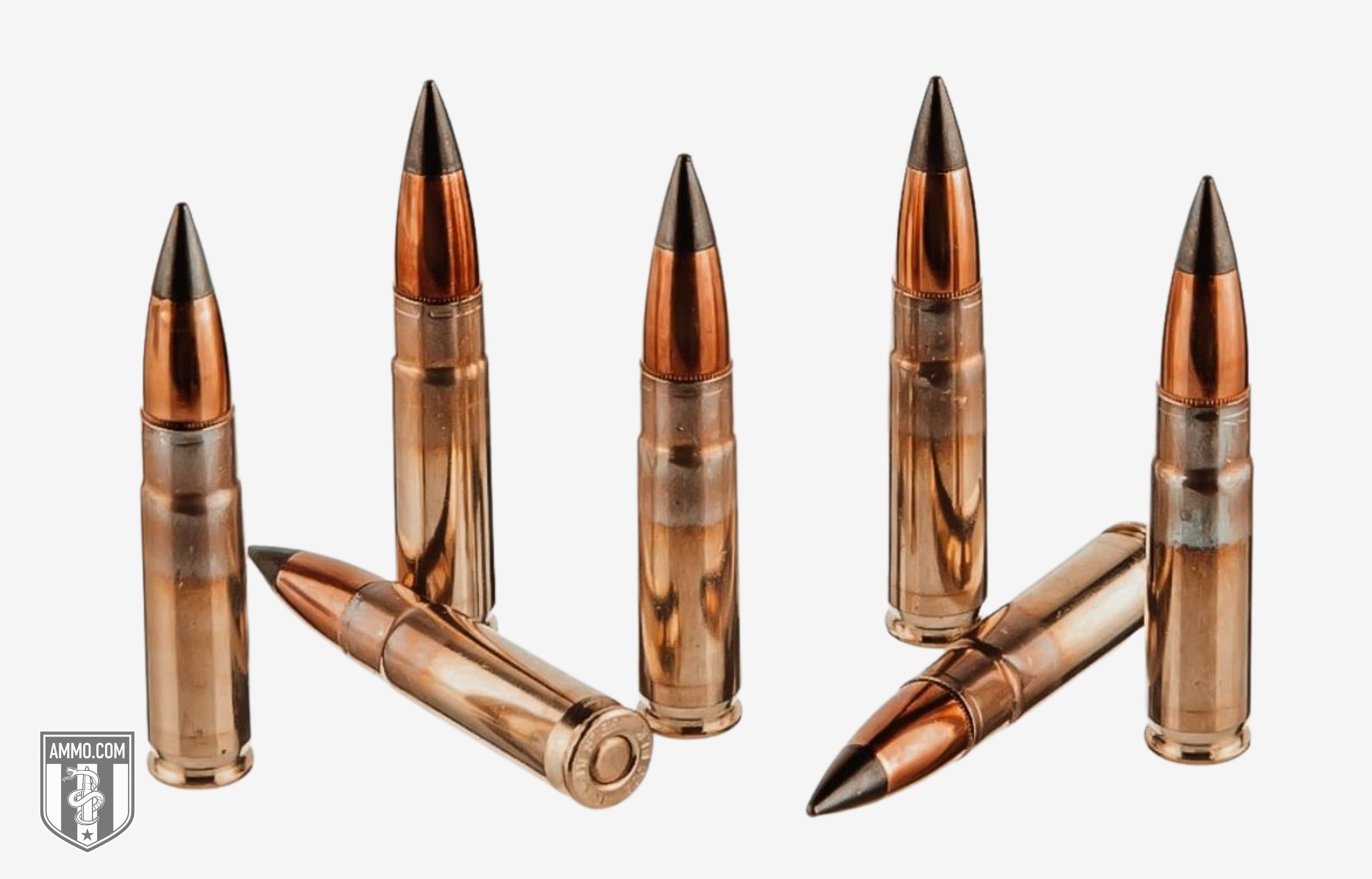6.5 Grendel vs. 300 Blackout: Which Semi-Auto Rifle Cartridge Is Better?
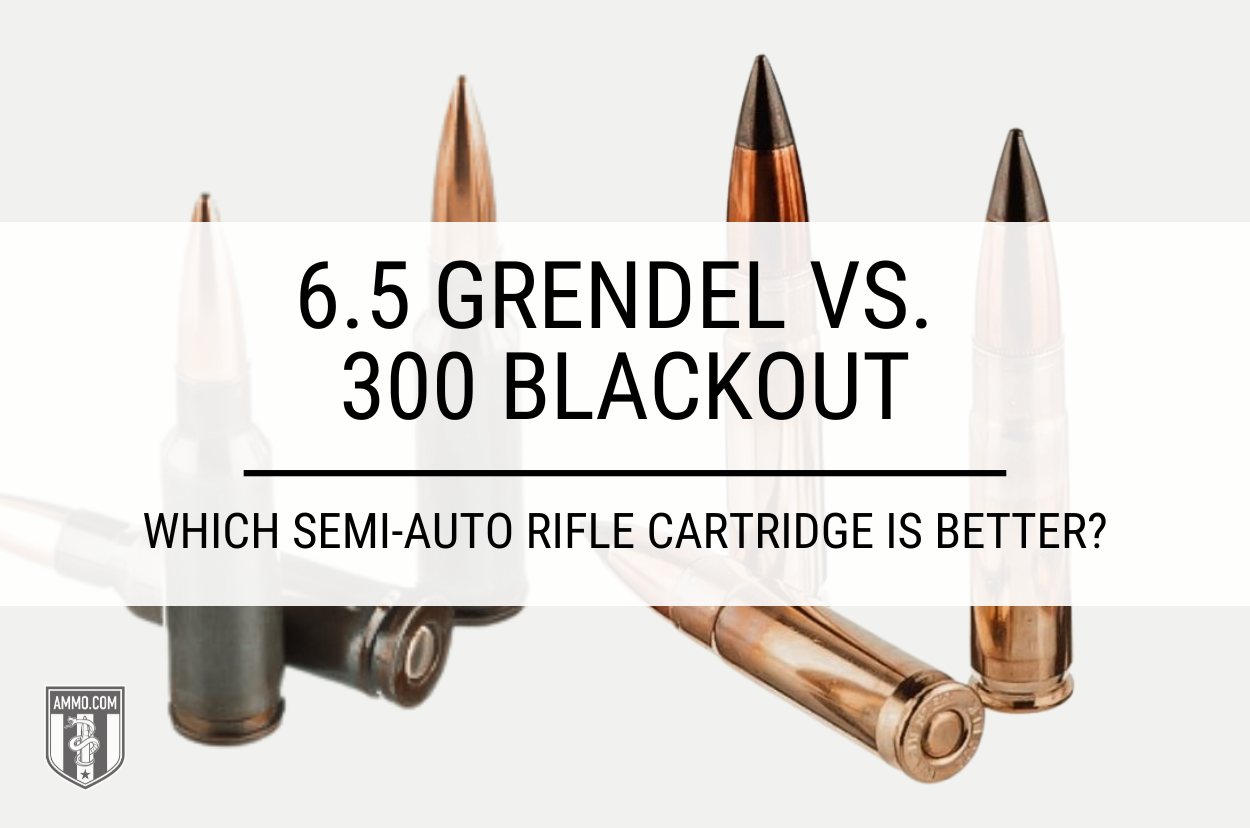
The 6.5 Grendel and 300 Blackout were designed to outperform the 5.56 NATO in the AR-15 platform. One uses a 6.5mm (.264 caliber) projectile; the other, a .30 caliber bullet.
As you continue reading, you’ll discover how the differences in cartridge size and projectile choice affect the performance of each round in the real world.
We’ll judge each cartridge on recoil, trajectory, accuracy, cost, and a few other critical factors.
6.5 Grendel vs. 300 Blackout Comparison
While both cartridges were designed for a similar purpose, they approached it differently and at various times in history.
The 300 BLK is a slightly newer cartridge (approved by SAAMI in 2011). The 6.5 Grendel was released in 2003, so the 300 AAC BLK has the advantage of correcting the mistakes that Bill Alexander, creator of the 6.5 Grendel, made.
Is the 300 Blackout an improvement on the 6.5 Grendel and 5.56 NATO?
Let’s find out by starting with the cartridges’ specs.
Cartridge Specs
At first glance, there are only minor differences in the cartridges' specs. You’ll notice that the 300 BLK has a larger bullet diameter (0.308 inches vs. 0.264 inches) than the 6.5 Grendel. The 300 AAC BLK is also capable of firing heavier bullets. The bullet weight range for the Blackout is typically between 110 to 220 grain (subsonic rounds), whereas the Grendel has a bullet weight range of 80 to 144 grain.
However, the 6.5 Grendel has a larger base diameter (0.439 inches vs. 0.376 inches) than the 300 AAC Blackout. The larger case lowers the magazine capacity and limits the number of rounds a soldier can carry onto the battlefield – one reason why it didn’t take off among national militaries.
The two rounds' overall lengths are identical because they were designed for the AR platform’s STANAG magazine. The case length of the 6.5 Grendel is 1.52 inches (compared to 1.368 inches for 300 BLK), which increases its case capacity over the 300 BLK (35 grains H2O for the Grendel and 26.5 grains H2O for the Blackout).
The maximum pressure of each cartridge is similar: 52,000 psi for the 6.5 Grendel and 55,000 psi for the 300 Blackout. Let’s see how these pressures and cartridge specs affect the recoil of each AR-15 cartridge.
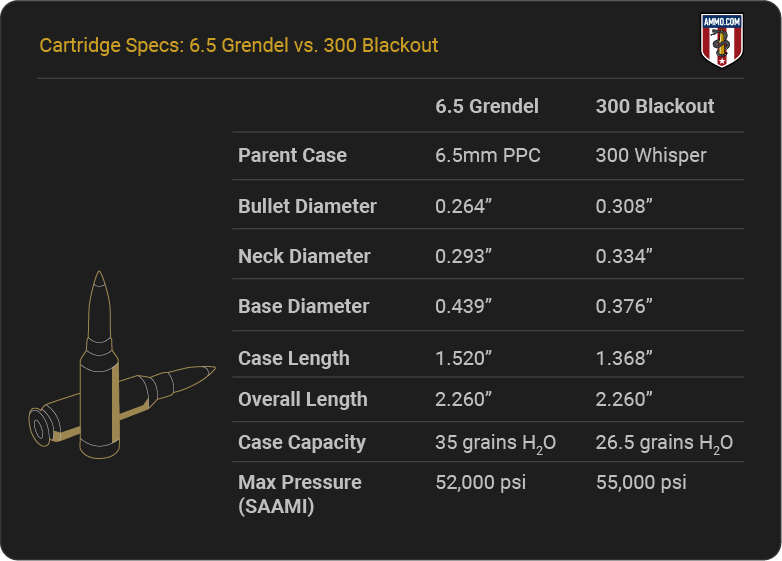
Recoil: 300 BLK vs. 6.5 Grendel
Recoil is an important consideration when purchasing a new rifle, as a round with heavy recoil will be more challenging to control and will slow your follow-up shot rate. Free recoil energy (ft-lbs) is determined by muzzle velocity (fps), propellant charge, bullet weight, and rifle weight. Felt recoil varies from shooter to shooter and cannot be scientifically measured.
The 6.5 Grendel has about 6 ft-lbs of free recoil energy, but it will vary from load to load. The 300 Blackout has about 4 ft-lbs of free recoil energy. While some shooters might notice a slight difference in recoil, these cartridges are quite similar.
The 300 BLK has a slight edge, as it typically has less recoil, especially when comparing lightweight projectiles.
The 300 Blackout wins this first section – but can it hold on to its lead?
Trajectory
Trajectory quantifies a bullet’s flight path to its target, measured in inches of bullet drop. A flatter trajectory is preferred because it requires the shooter to make fewer adjustments in pursuit of accuracy.
This is where the real differences begin to appear. The 300 BLK was designed for close-quarters combat (CQB), so a flat, long-range trajectory wasn’t mandatory for this cartridge. When sighted in at 100 yards, a 125 grain bullet with a muzzle velocity of 2,250 fps will have -7 inches of bullet drop at 200 yards, and -54.8 inches of bullet drop at 400 yards.
While the 6.5 Grendel can’t compete with the 6.5 Creedmoor regarding a flat trajectory, it’s much better than the 300 BLK. When zeroed in at 100 yards, a 123 grain bullet with a muzzle velocity of 2,580 fps will have -4.5 inches of bullet drop at 200 yards, and -35.3 inches of bullet drop at 400 yards.
The 6.5 Grendel ties it back up by having a much flatter trajectory.
Accuracy: 300 Blackout vs. 6.5 Grendel
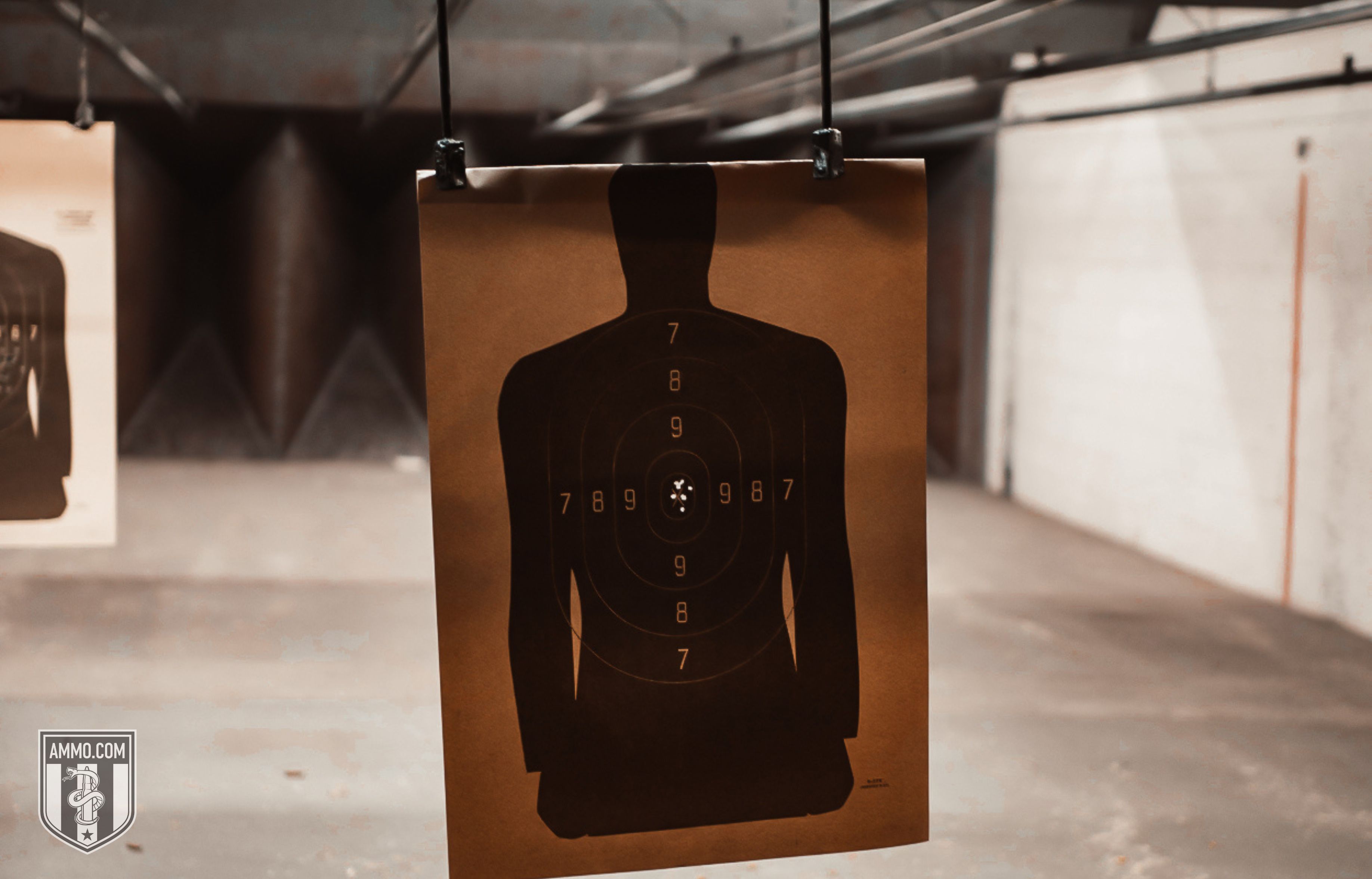
Accuracy is tricky to analyze as some factors cannot be calculated empirically. Rifle design, barrel life, ammo consistency, shooter skill, and environmental conditions contribute to accuracy.
Recoil also affects accuracy, especially when firing over longer ranges. Many shooters report being more accurate with a rifle that has less recoil. Again, this is because the shooter can focus more on the fundamentals of shooting (breath control, trigger squeeze, not disturbing sight alignment) rather than worrying about how badly the shot is going to hurt.
However, recoil isn’t different enough to severely impact accuracy in this comparison. Most shooters would struggle to tell the difference. Therefore, we should defer to the cartridge with a flatter trajectory.
The 6.5 Grendel will be more accurate, especially at longer ranges (200+ yards).
Ballistic Coefficient
The ballistic coefficient (BC) of a given bullet measures how well it resists wind drift and slices through the air. It’s a numeric representation of how aerodynamic a bullet is. A high BC is preferred, as the bullet will resist wind drift more efficiently, allowing the shooter to be more accurate.
Generally, a longer, heavier bullet will have a higher BC.
Some heavier subsonic bullets for 300 Blackout have an extremely high BC, such as the 208 grain Hornady A-MAX (0.648). That exception aside, most 300 BLK ammo generally has a BC between 0.267 and 0.393.
The 6.5 Grendel 123 grain Hornady SST has a BC of 0.510. In general, 6.5 Grendel ammo has a BC between 0.205 and 0.510.
Thanks to its heavier projectiles, the 300 BLK can have a higher BC. But when comparing similarly weighted bullets, the 6.5 Grendel has the edge, so this section is a tie.
Stopping Power: 6.5 Grendel vs. 300 BLK
“Stopping power” is a term thrown around to make you believe one cartridge is superior to another for defense and/or hunting. While things like energy transfer, penetration depth, and bullet size and design do matter, shot placement matters the most.
A poorly placed shot with a more powerful cartridge is less lethal than a well-placed shot with a less powerful cartridge.
With that out of the way, which one has more stopping power? The 6.5 Grendel has more kinetic energy to transfer to the target and is the more powerful round despite utilizing slightly smaller bullets.
The 6.5 Grendel wins this section.
Hunting

Neither cartridge was designed as a hunting round, but both have found success in hunters' hands. If I were limited to hunting with just these two cartridges, I see one clear winner.
The 300 BLK reminds me of the 30-30. It’s a suitable cartridge for close-range whitetail deer hunting, but it just doesn’t hold up well for shots over 200 yards.
Whether you’re looking to take down hogs, varmints, or deer, the 6.5 Grendel is a better option, as it has an extended hunting range and packs a little more punch than the 300 AAC Blackout.
The 6.5 Grendel wins this section thanks to its flatter trajectory and harder punch. Simply put, it lets you kill deer from farther away.
Home Defense: 6.5 Grendel vs. 300 AAC Blackout
I’m not a fan of using a rifle for home defense because rifle cartridges are more likely to over-penetrate and endanger your family and neighbors. But that doesn’t mean you shouldn’t use one if that’s all you have available to you. While I prefer using a shotgun or pistol for home defense, a rifle is better than nothing, especially when it’s chambered in one of these cartridges.
They’re great because they’re both designed for the AR-15 platform, a semi-automatic rifle that can be easily customized.
However, the 300 BLK is the better option for a few reasons.
First, the 300 BLK cartridge was designed for close-quarters combat, a situation similar to self-defense scenarios. Second, the slightly smaller cases allow for more rounds per magazine (if it’s legal in your state), and you can never have too much ammo! Lastly, it performs well in short-barrel rifles (SBR) and while shooting suppressed.
The 300 Blackout wins this section because it was created for close-quarters combat.
Cost & Availability
Owning the latest and greatest cartridges is cool, but most of us must stick to a budget if we enjoy living indoors and feeding our family. That’s why cost and availability should be considered.
Even though it’s the newer cartridge, the 300 Blackout has been more widely adopted than the 6.5 Grendel, which means 300 AAC BLK ammo is a little more abundant and slightly less expensive. You also have a more comprehensive selection of bullet weights and designs from factory loads.
With that said, the 6.5 Grendel is a reasonably priced and available rifle cartridge. It’s popular enough that many of the major ammunition manufacturers produce 6.5 Grendel ammo at a competitive price, with varying bullet styles and weights.
The 300 Blackout wins this section with more availability and lower overall cost, so it’s also better for plinking.
Reloading: 300 AAC BLK vs. 6.5 Grendel
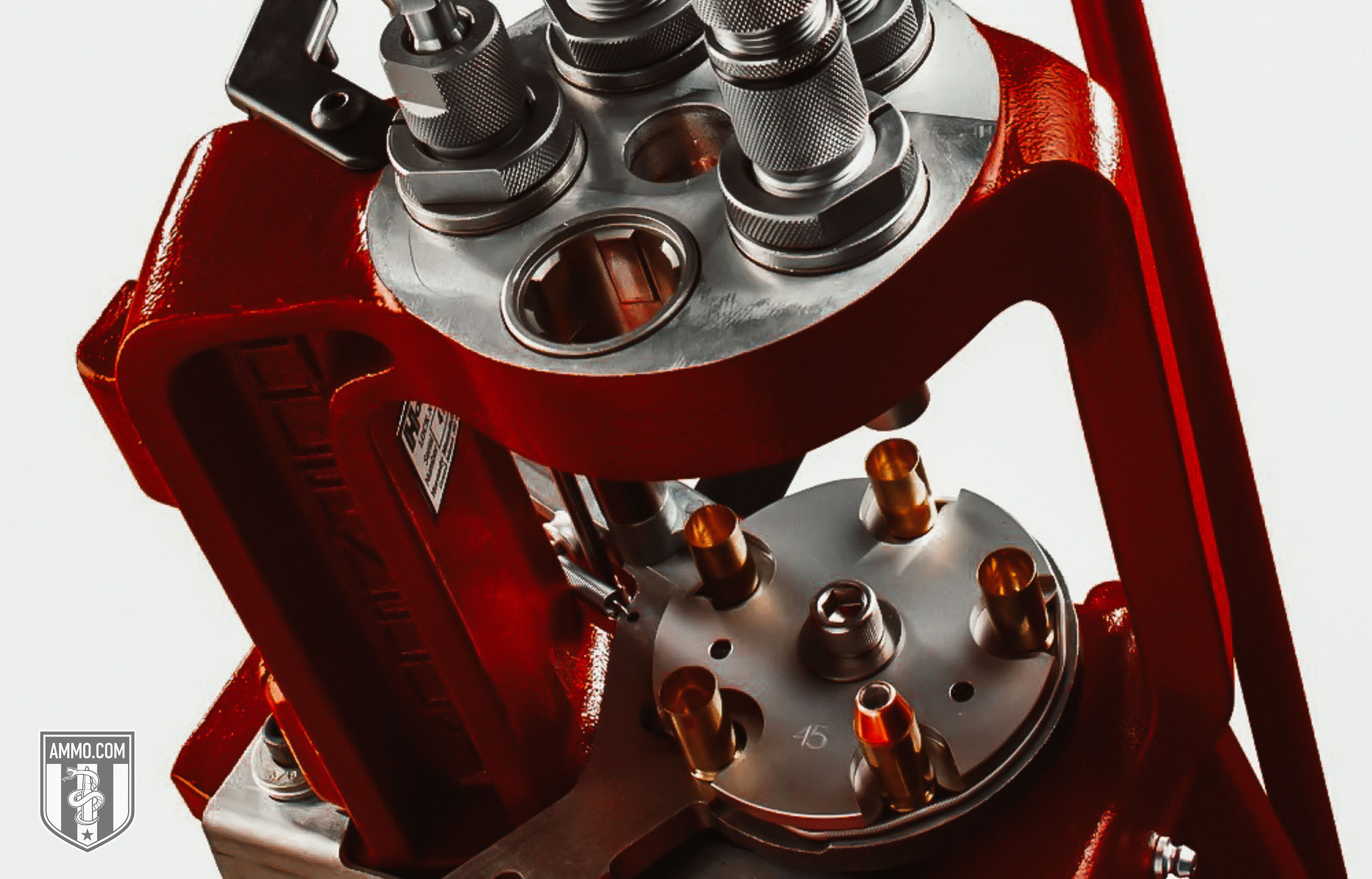
Consider reloading to save money on ammo. Handloading allows you to craft the perfect round for your rifle and save money while doing it.
However, purchasing reloading equipment and supplies has a significant initial cost; the savings will depend on how efficiently you can reload. Another way to compound your savings is to purchase bulk ammo and reload the spent brass.
American shooters commonly reload the 300 BLK and 6.5 Grendel.
Both cartridges have plenty of load data and supplies, so this section is a tie.
What Are The Ballistic Differences Between 6.5 Grendel and 300 Blackout?
This is the moment all the number crunchers have been salivating: the ballistics tables! The team at Ammo.com has compiled the ballistics of each cartridge in easy-to-read tables so you can quickly compare them.
6.5 Grendel Ballistics
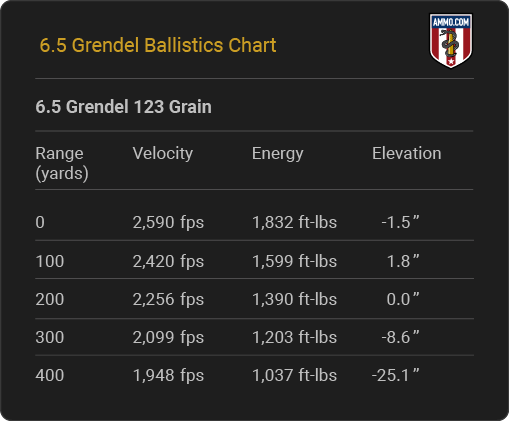
300 Blackout Ballistics

Check out our 300 Blackout ballistics tables article for a deeper dive into specific ammunition.
6.5 Grendel Brief History
Bill Alexander of Alexander Arms announced the 6.5 Grendel in May 2003. The new rifle cartridge was also developed with the help of senior ballistician Janne Pohjoispää of Lapua and competitive shooter Arne Brennan.
The goal of the 6.5 Grendel cartridge was to develop a cartridge that extended the effective range of AR-15 rifles farther than 800 yards. The 6.5 Grendel maintains supersonic velocities and MOA-level accuracy out to 1,200 yards with half the recoil of the .308 Winchester.
The 6.5mm PPC is the parent case for the 6.5 Grendel, which has a wider case head than the 5.56x45mm, so it requires a non-standard AR-15 bolt and special magazines for use in AR-15 rifles.
Bill somewhat hindered the widespread adoption of the 6.5 Grendel because he insisted that the cartridge be trademarked. So it could not be standardized by SAAMI. However, in 2010 Hornady and Alexander Arms collaborated to register the 6.5 Grendel with SAAMI, allowing other manufacturers to make and sell 6.5 Grendel ammo, greatly expanding the cartridge's reach.
With exceptional barrel life, long-range shooting capability, and MOA-level accuracy, the 6.5 Grendel is a solid choice if you desire to upgrade your AR-15 to something with a bit more stopping power than the 5.56 NATO/.223 Rem.
300 Blackout Brief History
The 300 BLK is the 2nd most popular chambering for the AR platform, but many initially thought it was a fad that would quickly fade.
The 300 AAC Blackout was approved by SAAMI in 2011 after being developed by Robert Silvers of the Advanced Armament Corporation (later acquired by Remington) and a US Military “dark ops” community member.
It needed to meet the following requirements:
- The new rounds needed to fit into a standard STANAG AR-pattern magazine and maintain a 30-round ammo capacity.
- The cartridge case head must be the same as 5.56mm NATO, so a bolt change was unnecessary.
- It had to shoot 30-caliber bullets and mimic the ballistic performance of the 7.62x39mm Soviet round.
- The new rifle cartridge must be compatible with short-barreled rifles (SBR, barrels under 16”) and completely functional with a suppressor/silencer.
- Both supersonic and subsonic varieties of ammo needed to be functional for long-range shots and close-quarters battles, respectively.
Silvers used the 300 Whisper, a wildcat cartridge, as the parent case to meet all the demands and create the 300 AAC Blackout.
Frequently Asked Questions
The team at Ammo.com has gathered and answered some of the most commonly asked questions regarding the 300 BLK vs. 6.5 Grendel.
How does barrel length affect performance for 6.5 Grendel and 300 Blackout?
A longer barrel increases either cartridge's muzzle velocity, accuracy, and effective range because it allows the powder to burn more completely.
Which is better, 6.5 Grendel or 300 Blackout?
The 6.5 Grendel is better for deer hunting at distances greater than 200 yards. The 300 Blackout is better for home defense.
What is a 6.5 Grendel equivalent to?
The 6.5 Grendel is comparable to the 5.56x45mm NATO, 220 Russian, 6.5mm PPC, and 7.62x39mm.
Parting Shots
Now that you’ve finished reading our 6.5 Grendel vs. 300 Blackout comparison, you know each cartridge performs better in specific situations.
The 6.5 Grendel won four sections (trajectory, accuracy, knockdown power, and hunting). Two sections were a tie (ballistic coefficient and reloading). The 300 Blackout won three sections (recoil, home defense, and overall cost).
If you plan to hunt with either of these cartridges, the 6.5 Grendel is the clear winner. If you plan to use it for home defense, I recommend using the 300 BLK.
No matter which cartridge you choose, we have a large ammo selection available at reasonable prices at Ammo.com.
Ammo Comparisons
- .308 vs 5.56
- 6.5 Creedmoor vs .308
- .300 Blackout vs .308
- .300 Win Mag vs .308
- .243 vs .308
- .308 vs .30-06
- 7mm-08 vs .308
- .270 vs .308
- 7.62x39 vs .308
- .223 vs .308
- .338 Lapua vs .308
- .380 ACP vs 9mm
- .223 vs 5.56
- .300 Blackout vs 5.56
- 9mm vs 45 ACP
- 9mm vs 40 S&W
- .357 SIG vs 9mm
- 10mm vs 9mm
- 9mm vs 9mm Luger
- .243 vs .270
- .300 Win Mag vs .30-06
- .270 vs .30-06
- .40 vs .45
- 38 Special vs 357
- 9mm vs 40 vs 45
- 5.56 vs 7.62x39
- 338 Lapua vs .30-06
- .30-30 vs .30-06
- 300 PRC vs 338 Lapua
- .30-06 vs 7mm
- 300 Win Mag vs 338 Lapua
- 300 PRC vs 300 Win Mag
- 300 WSM vs 300 Win Mag
- 338 Win Mag vs 338 Lapua
- 12 Gauge vs 20 Gauge
- 10mm vs 357 Mag
- .30-30 vs 7.62x39
- 224 Valkyrie vs 22-250
- 17 HMR vs 22 Mag
- 7.62x39 vs .300 Blackout
- 45 ACP vs 45 Auto
- 45-70 vs 30-30
- 300 Blackout vs 223
- 357 Magnum vs 9mm
- 350 Legend vs 300 Blackout
- 224 Valkyrie vs 223
- 45 ACP vs 38 Super
- 6.5 Grendel vs .308
- 17 HMR vs 22 LR
- 10 Gauge vs 12 Gauge
- 22-250 vs 223
- 45 Colt vs 45 ACP
- 350 Legend vs 30-30
- 5.7x28 vs 223
- 5.7 vs 9mm
- 5.56 vs 5.7
- 22 vs 9mm
- Buckshot vs Birdshot
- 450 Bushmaster vs 308
- 450 Bushmaster vs 223
- Buckshot vs Slug
- 6.5 Grendel vs 5.56 vs 223
- 6mm ARC vs 6.5 Grendel
- 44 vs 45
- 458 SOCOM vs 5.56
- 357 vs 44
- 32 ACP vs 380
- 300 Win Mag vs 338 Win Mag vs 338 Lapua Mag
- 450 Bushmaster vs 458 SOCOM vs 50 Beowulf
- 6mm Creedmoor vs 6.5 Creedmoor
- TMJ vs FMJ
- 44 Special Vs 44 Magnum
- 45 90 vs 45 70
- 6.8 Western vs 6.8 SPC
- 50 Beowulf vs 50 BMG
- 26 Nosler vs 6.5 PRC
- 28 Gauge vs 410
- 6.8 SPC vs 5.56
- 6.8 SPC vs 6.5 Grendel
- 6.8 Western vs 7mm Rem Mag vs .28 Nosler
- 6.8 Western vs 6.5 Creedmoor
- 22 Hornet vs 223
- 6.8 Western vs 6.5 PRC
- .410 vs 12 Gauge
- .410 vs 20 Gauge
- 22 LR vs 22 Mag
- 6mm ARC vs 243
- 7mm-08 vs 270
- 243 vs 6.5 Creedmoor
- Nickel vs Brass Casing
- 204 Ruger vs 223
- 50 Beowulf vs 5.56
- 260 Remington vs 6.5 Creedmoor
- 6mm Remington vs 243
- 28 Nosler vs 300 PRC
- 50 Beowulf vs 50 AE
- 22 Nosler vs 22-250
- 450 Marlin vs 45-70
- 300 Win Mag vs 300 Norma
- 458 SOCOM vs 300 Blackout
- 38-55 vs 45-70
- 22 Hornet vs 22 LR
- 300 Norma vs 338 Lapua
- 338 Lapua vs 50 BMG
- 28 Nosler vs 300 Win Mag
- 28 Nosler vs 6.5 Creedmoor
- 204 vs 22-250
- 458 SOCOM vs 45 70
- 44 40 vs 45 70
- 6.8 SPC vs 6.5 Creedmoor
- 450 Bushmaster vs 30-06
- 7mm Rem Mag vs 300 Win Mag
- 30 Carbine vs 223
- 25-06 vs 30-06
- 26 Nosler vs 28 Nosler
- 16ga vs 12ga
- 30 06 vs 7.62 x54R
- 9mm Makarov vs 9mm Luger
- 350 Legend vs 223
- 30 Carbine vs 5.56
- 6.5x55 vs 6.5 Creedmoor
- 6.5 Creedmoor vs 270 vs 25-06
- M193 vs M855
- 450 Bushmaster vs 458 SOCOM
- 6.5 Grendel vs 6.5 Creedmoor
- 350 Legend vs 5.56
- .277 Fury vs 6.8 SPC
- 277 Fury vs 300 Win Mag
- 10mm vs .45 ACP
- 277 Fury vs 223
- 6.8 SPC vs 300 Blackout
- 6.5 PRC vs 6.5 Creedmoor
- 277 Fury vs 308
- 277 Fury vs 6.5 Creedmoor
- 350 Legend vs 450 Bushmaster
- 277 Fury Vs 5.56 NATO
- 10mm vs 40S&W
- 32 ACP vs 9mm
- 32 Special vs 9mm
- 8.6 Blackout vs 300 Blackout
- 30 Super Carry vs. 9mm
- 5.56 vs 9mm
- .50 Action Express vs 9mm
- 7.62x25 vs. 9mm
- 10mm vs 44 Magnum
- 300 Blackout vs 300 Win Mag
- 6.5 Grendel vs 300 Blackout
- 460 Rowland vs 10mm
- 300 RUM vs 300 PRC
- 300 Norma vs 300 PRC
- 45 GAP vs 45 ACP
- 7mm PRC vs 300 Win Mag
- 300 PRC vs 6.5 Creedmoor
- 300 PRC vs 308
- 357 SIG vs 357 Mag
- 7.62x39 vs 7.62x51
- 243 Win vs 223 Rem
- 30 Nosler vs 300 PRC
- 6.5 Creedmoor vs. 30-06 Springfield
- 450 S&W vs. 44 Magnum
- 6.5 Creedmoor vs. 300 Win Mag
- 454 Cassull vs. 45-70 Govt
- 454 Cassull vs. 44 Mag
- 7.62x54r vs. 308 Winchester
- 22 ARC vs. 223 Rem
- Subsonic vs. Supersonic Ammo
